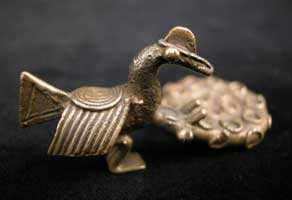Asante Brass Goldweight (abrammuo), 18th Century CE - 19th Century CE
Brass
2.25
FZ.326
This magnificent Asante goldweight depicts a hornbill caught by a snake. This relates to a traditional Akan proverb: ‘Although the snake does not fly, it has caught the hornbill, whose...
This magnificent Asante goldweight depicts a hornbill caught by a snake. This relates to a traditional Akan proverb: ‘Although the snake does not fly, it has caught the hornbill, whose home is in the sky.’ The message is one of optimism and patience. According to the legend, the hornbill was indebted to the snake but refused to settle its debts because it reasoned that it could always fly away if challenged. The snake however waited quietly and patiently and eventually emerged triumphant. The craftsmanship is superb, especially the details in the bird's feathers and the raised circular pattern on the snake’s skin.
The Asante come from Ghana, and were related to a wider group of peoples linked through their common use of the Akan language. Gold fueled the Asante rise to prosperity and was traded first across the Sahara and ultimately to Europe and the Americas. Brass gold weights were part of the paraphernalia of the trade, that also included scales, spoons, shovels and gold dust boxes. Created out of brass using the ‘lost wax process’, they were placed on scales to counterbalance piles of gold dust. The earliest examples, dating from the fourteenth century, were abstract in form but by the later period they assumed a wide variety of figurative and zoomorphic shapes. Ownership of a complete set of elaborate weights was regarded as a mark of status, and they were often presented to young men at their weddings to mark the start of their business careers. The skill in casting these weights was enormous as in addition to their aesthetic appeal they had to weigh a specific amount. Even the most beautiful figurative weights occasionally had limbs or horns removed or filed away to achieve this. Another examples would have small lead rings or glass beads attached to bring the weight up to the desired standard. The enthusiasm for these elaborate weights which had obvious practical drawbacks demonstrates the significance that the Akan peoples attached to proverbial wisdom in the conduct of their everyday lives. (AM)
The Asante come from Ghana, and were related to a wider group of peoples linked through their common use of the Akan language. Gold fueled the Asante rise to prosperity and was traded first across the Sahara and ultimately to Europe and the Americas. Brass gold weights were part of the paraphernalia of the trade, that also included scales, spoons, shovels and gold dust boxes. Created out of brass using the ‘lost wax process’, they were placed on scales to counterbalance piles of gold dust. The earliest examples, dating from the fourteenth century, were abstract in form but by the later period they assumed a wide variety of figurative and zoomorphic shapes. Ownership of a complete set of elaborate weights was regarded as a mark of status, and they were often presented to young men at their weddings to mark the start of their business careers. The skill in casting these weights was enormous as in addition to their aesthetic appeal they had to weigh a specific amount. Even the most beautiful figurative weights occasionally had limbs or horns removed or filed away to achieve this. Another examples would have small lead rings or glass beads attached to bring the weight up to the desired standard. The enthusiasm for these elaborate weights which had obvious practical drawbacks demonstrates the significance that the Akan peoples attached to proverbial wisdom in the conduct of their everyday lives. (AM)
5
of
5



